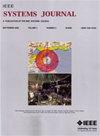Performance Analysis of STAR-RIS Aided Short-Packet NOMA Network Under Imperfect SIC and CSI
IF 4.4
3区 计算机科学
Q1 COMPUTER SCIENCE, INFORMATION SYSTEMS
引用次数: 0
Abstract
Simultaneously transmitting and reflecting reconfigurable intelligent surface (STAR-RIS) and nonorthogonal multiple access (NOMA) are promising solutions for next-generation wireless networks with massive connectivity, ultra-low latency, ultra-high reliability, and spectral efficiency. This article analyzes the performance of the downlink STAR-RIS-aided short-packet (SP)-NOMA (STAR-RIS-SP-NOMA) network under the constraint of imperfect successive interference cancellation (ipSIC) and imperfect channel state information (ipCSI) by using a Nakagami-不完全SIC和CSI条件下STAR-RIS辅助短包NOMA网络性能分析
同时传输和反射可重构智能表面(STAR-RIS)和非正交多址(NOMA)是下一代无线网络具有大规模连接、超低延迟、超高可靠性和频谱效率的解决方案。本文利用Nakagami-$m$衰落环境,分析了下行链路star - ris辅助短包(SP)- noma (STAR-RIS-SP-NOMA)网络在不完全连续干扰抵消(ipSIC)和不完全信道状态信息(ipCSI)约束下的性能。为了描述系统的性能,首先,我们使用拉格尔多项式级数近似推导了级联Nakagami-$m$信道的统计分布。其次,导出了平均块错误率(ABLER)、系统吞吐量、goodput、延迟和可靠性的近似封闭表达式。第三,渐近分析也在高信噪比下进行,以获得进一步的见解。最后,通过蒙特卡罗仿真验证了理论结果的正确性。数值结果验证了STAR-RIS-SP-NOMA优于star - ris - sp -正交多址(OMA) (STAR-RIS-SP-OMA)和传统的协同通信场景,如解码和转发中继辅助半双工sp -OMA和固定增益放大和转发中继辅助半双工sp -OMA。我们比较了所有三种STAR-RIS操作方案的ABLER表达。此外,还研究了各种参数对系统性能的影响,如ipCSI相关因子、ipSIC因子、块长度、信息位和STAR-RIS元素数量。
本文章由计算机程序翻译,如有差异,请以英文原文为准。
求助全文
约1分钟内获得全文
求助全文
来源期刊

IEEE Systems Journal
工程技术-电信学
CiteScore
9.80
自引率
6.80%
发文量
572
审稿时长
4.9 months
期刊介绍:
This publication provides a systems-level, focused forum for application-oriented manuscripts that address complex systems and system-of-systems of national and global significance. It intends to encourage and facilitate cooperation and interaction among IEEE Societies with systems-level and systems engineering interest, and to attract non-IEEE contributors and readers from around the globe. Our IEEE Systems Council job is to address issues in new ways that are not solvable in the domains of the existing IEEE or other societies or global organizations. These problems do not fit within traditional hierarchical boundaries. For example, disaster response such as that triggered by Hurricane Katrina, tsunamis, or current volcanic eruptions is not solvable by pure engineering solutions. We need to think about changing and enlarging the paradigm to include systems issues.
 求助内容:
求助内容: 应助结果提醒方式:
应助结果提醒方式:


